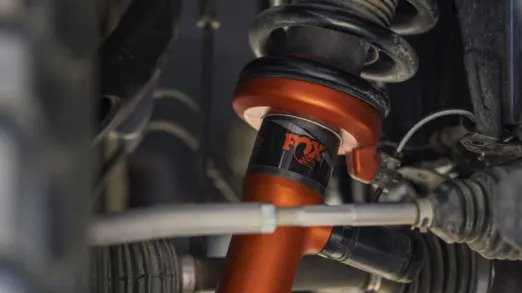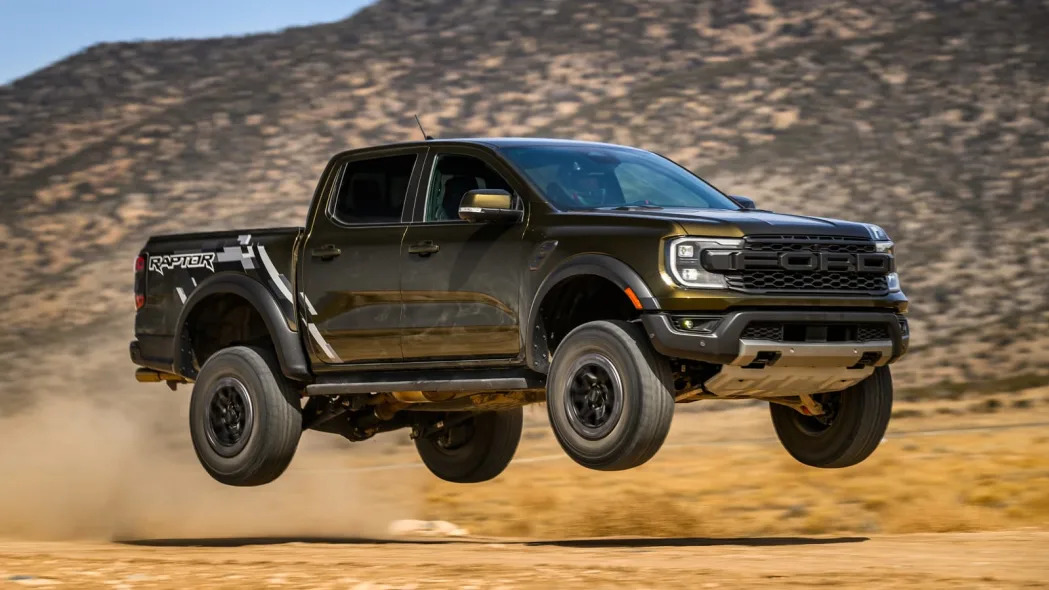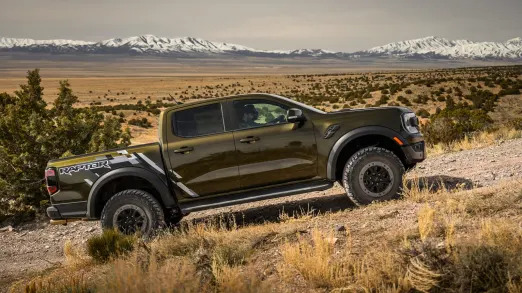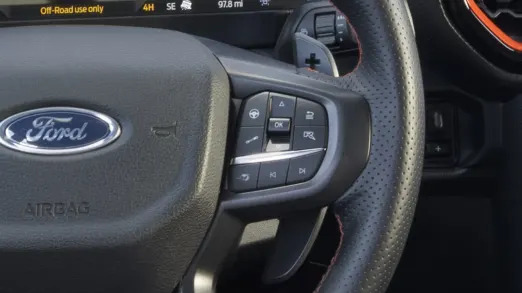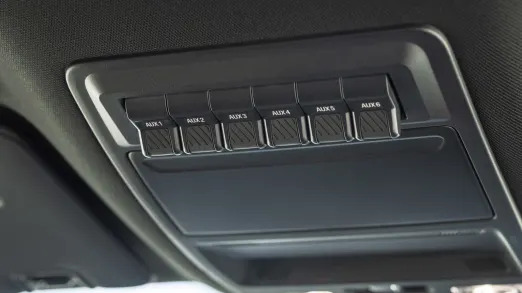STOCKTON, Utah – “Where the hell am I supposed to drive this?” was roughly my impression of the Bronco Raptor, an SUV so annoyingly wide that it needs government-mandated marker lights. It also boasts 418 horsepower, enormous 37-inch tires and a suspension designed to cushion landing back on Earth after you’ve launched 5,733 pounds off its surface. Because that’s something you can routinely do. All of the above is amplified in the F-150 Raptor, but at least that can fit a fridge in its bed. Both are basically the off-road equivalents of a Lamborghini Aventador: immensely capable, hyper-masculine and, day-to-day, incredibly ridiculous.
The new 2024 Ford Ranger Raptor is not ridiculous. Its track is 3.5 inches wider than the base truck and its fenders flared to cover the 33-inch tires, but excluding the mirrors, the Ranger Raptor’s width grows by only 4.3 inches. With the mirrors in place or folded, it’s exactly the same. By contrast, the Bronco Raptor is 9.8 inches(!) wider than the standard version with the mirrors folded, and even 6.4 inches wider than the big-tired Wildtrak. The Ranger Raptor is a few tenths narrower than that.
So while the Ranger’s extra track and big tires grant it greater stability, the common width doesn’t leave you wincing at the sight of every branch lining a trail or searching for RV parking just to claim a sufficiently wide space. And true, the Ranger Raptor is almost 20 inches longer than its Bronco platform mate (the difference between a truck bed and an SUV cargo area), but it absolutely doesn’t feel it. While the other Raptors are intense brutes designed go fast in wide-open spaces of desert – sort of muscle cars of the sand – the Ranger Raptor feels lithe and flickable. That’s partly a result of perception given its size, but also because of how Ford’s engineers intended it.
And by “engineers,” I don’t just mean those who call Michigan home. Like the entire 2024 Ford Ranger lineup, the Raptor is a global product, and the lions’ share of its tortuous development occurred on, through and over rusty red sands Down Under.
“It’s been a labor of love for us in Australia,” said Ford Performance and Special Vehicle Programs Manager Justin Capicchiano, who made the 22-hour trek from Melbourne, Australia, to brief the assembled journalists in Utah. After making roughly the same point about the Bronco and F-150 Raptor’s ideal performance arena, Capicchiano added that achieving a higher degree of agility was of paramount importance for the Ranger Raptor. He noted that while we would be making our way through generously spaced cones in wide-open desert, his team was snaking through groves of “soap trees and eucalyptus.”
To that end, the suspension features lighter-weight aluminum control arms and a long-travel rear suspension with trailing arms and a Watts linkage. Those would be the bars funkily attached to the diff from each wheel. Crucially, like the F-150 Raptor, the rear end has coils in place of the standard truck’s leaf springs. Seventeen-inch wheels (beadlocks are optional) wrap those 33-inch BFGoodrich all-terrains – no 37s here. It wouldn’t be a Raptor without Fox shocks, and the Ranger has next-generation 2.5-inch Live Valve Internal Bypass hardware that alters its damping performance based on the various drive modes or steering wheel button. They’re also swell for achieving a cushy landing, and despite all the talk of agility, the Bo and Luke Duke schtick will always be on the Raptor menu.
To that end, the front frame rails, front shock towers, rear shock brackets and suspension mounting points were all strengthened. And yes, I did jump the Ranger Raptor and, honestly, it was anticlimactic. Credit assuredly goes to the enhanced hardware, but we weren’t actually allowed to give it the full, well, this …
The restrictions were significantly eased on the handling course, which is the primary arena for the new Raptor Assault driving school that buyers of any Raptor now get a one-day admission to. Normally, the collection of small circuits cut through the desert an hour west of Salt Lake City would be a reasonable facsimile for the dusty, sandy conditions of Baja, California, which inspires the name of the Raptor’s most intense drive mode. On this day, however, the circuits are a mucky mess. Sticky mud cakes the tires, water pools at the bottom of landing zones, corners resemble pig pens … let’s just say when the driving instructor tells you there’s not going to be any grip when the goal was originally to drive on sand, you know it’s bad.
Here’s the thing, though. I wasn’t being timed; I wasn’t trying to go fast enough to prove the truck’s limits. If you’re just trying to have some slidey, splashy, rooster-tailing fun without killing yourself or bashing the truck, the Ranger Raptor is a tremendous toy. The drone footage of my runs is hilarious – I had to check to see if it was filmed in slow-motion, but nope, it just looked like I was trying to find a parking spot. Didn’t feel it, though, and it didn’t matter. It was a hoot to flick the Ranger Raptor into a slick corner, goose the throttle to coax the rear end to slide, then nurse it to maintain an arc, before flicking the wheel back in the opposite direction to start all over again. Baja mode’s looser stability control reins make this tomfoolery possible, by the way, but do keep those reins primed just in case you get a little over-eager. You can also turn them off completely for full yee-haw.
Later, I would get into the passenger seat next to Anthony Magagnoli, an Off-Road Attributes Engineer at Ford. Basically, it is his job to go fast enough to prove the truck’s limits. He was largely doing what I was doing around corners, but at, like, three times the speed. It was like someone hit fast-forward on the world. Maintaining such a pace through soap trees and eucalyptus would be terrifying. Good on ya, mates. Anyway, it was even easier to detect the Ranger Raptor’s elevated sense of agility when at a much quicker pace and when I wasn’t the one doing the driving – it felt more like riding shotgun in a WRX than something called Raptor.
We also managed to do some rock crawling at the nearby Sunshine Canyon Road OHV Loop. The Raptor has better clearances than the standard Ranger, with an approach angle of 33 degrees (versus 30.2), a departure angle of 26.4 (25.8), a ramp breakover angle of 24.2 (23.0) and a minimum ground clearance of 10.7 inches (9.3). That’s the exact same ground clearance of the Colorado ZR2, which has a better approach, worse departure and ballpark-ish break-over. The Tacoma TRD Off-Road is broadly similar, which is to say that the TRD Pro will likely be greater. The Colorado ZR2 Bison is matter-of-fact greater. Indeed, the rock crawling we attempted at Sunshine Canyon was a leisurely sashay through the country compared to the “Are you kidding me?” boulder field I tackled in the Bison. We didn’t even have spotters in the Raptor – just the useful array of onboard cameras, plus orders over the radio to engage the “Off-Road” or more aggressive “Rock Crawl” drive modes, select the front or rear lockers using the touchscreen menu that remains in place when in those modes, and engage the Trail Control off-roading cruise control system that did its job. Normally, I’d say “that’s what your feet are for,” but giving it a whirl on the slippery terrain where the system can stab individual brakes nevertheless proved its value.
In other words, the Raptor can do some rock crawling, and given its more manageable dimensions, it’ll be easier and more fun to do so than in the Bronco or F-150. Compared to other hardcore choices, the answer is probably “not as good,” but then rock crawling isn’t for everyone. I know I’d rather be slip-sliding and jumping mounds in the desert than bashing side rails at 1.7 mph. And to that end, the Ranger Raptor will totally thwack its competitors with what it’s packing under the hood: a 3.0-liter turbocharged V6 good for 405 horsepower and 430 pound-feet of torque. That might be the same torque as the ZR2 and 6 fewer pound-feet than the TRD Pro’s hybrid four-cylinder, but the horsepower? Not even remotely close.
There aren’t any long straights at Raptor Assault to really let the big turbo V6 fly, so the best I could do was a couple full-wood acceleration runs up to the listed speed limit on Highway 73 (our on-road driving was limited only to a 30-minute trek on said highway). Like the Bronco Raptor, which has the same engine with a few extra horses but tasked with moving 408 extra pounds, don’t expect giggle-inducing, high-five-your friends thrust. Yet, it still gets up to speed with a smooth, effortless punch and sounds great doing it, thanks to an exhaust with four levels of volume: Quiet, Comfort, Sport and Baja, which the IP tells you is for “Off-Road Use Only.” I’m sure owners will totally follow that.
You can make your exhaust selection using a dedicated steering wheel button. There are also buttons for the shocks and steering, plus an R button that quickly summons your customized menu of factors. This is a level of customization that was sorely missing in the new Mustang … which could also use the beautiful, real-metal paddle shifters attached to the Raptor’s thick, grippy steering wheel. There is also a standard assortment of drive modes – Normal, Tow/Haul, Slippery, Off-Road, Rock Crawl and Baja – selected with the same center console knob also assigned to the Trailer Reverse Guidance system (read about it in our standard Ranger first drive). A button in the center engages that functionality with transfer case buttons surrounding it in a neat little package.
Elsewhere in the cabin, the seats have chunkier bolsters accented in Code Orange, a color also trimming the air vents. That, plus the wheel and a row of AUX switches in the ceiling, is the extent of Raptor-specific elements in an interior that’s otherwise the same as what you’d find in the loaded Lariat trim (including extra soft-touch vinyl on the dash and doors). I don’t think it looks as good as the Colorado ZR2 or GMC Canyon AEV cabins, but the quality is right there, if maybe higher. It also gets the same, user-friendly 12-inch touchscreen interface and handsome, customizable 12-inch instrument display as the Lariat.
Pricing starts at $57,065, including destination. A base Colorado ZR2 is $8,000 less, but the difference shrinks to $6,230 when similarly equipped. A Bison goes for $62,535. A GMC Canyon AT4X is actually a few hundred pricier than the Raptor to start, and while Tacoma TRD Pro pricing hasn’t been announced, the Limited version starts over $53,000, so that seems like a decent guestimate. Overall, I’d say that makes the Raptor competitively priced. It’s also a lot cheaper than its siblings – the 2024 Bronco Raptor crests $91,000, while the 2023 F-150 Raptor was just under $80,000. From a performance perspective, that makes the Ranger a substantially better deal than the Bronco, and unless you need a more family-friendly back seat, I think it’s just better in general. The F-150 is obviously far more capable in terms of its truck-ness, and there’s no denying the difference in sheer presence. No one is going to raise a can of Monster towards your Ranger Raptor if an F-150 is close by.
Much like comparing a lithe sport coupe to a brutish muscle car, though, the Ranger Raptor’s appeal is about so much more than just being cheaper. Jumping gorges is fun and all, but I’d wager you’d be able to have more fun more often in the Ranger while not suffering so much when you just need to go to Kroger. Where are you supposed to drive it? Anywhere.



